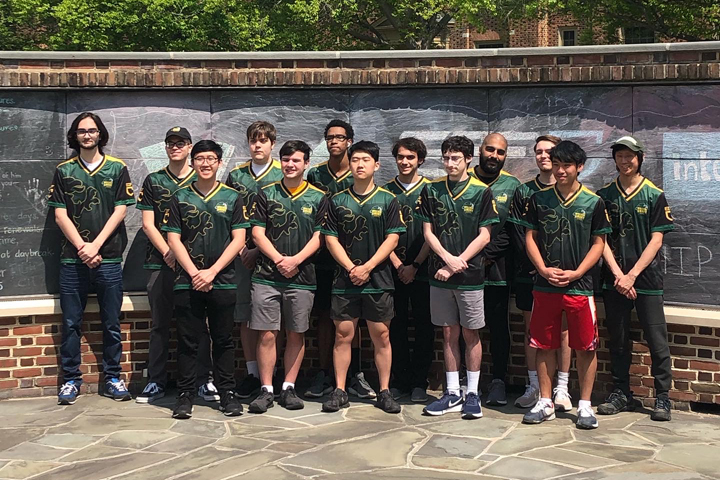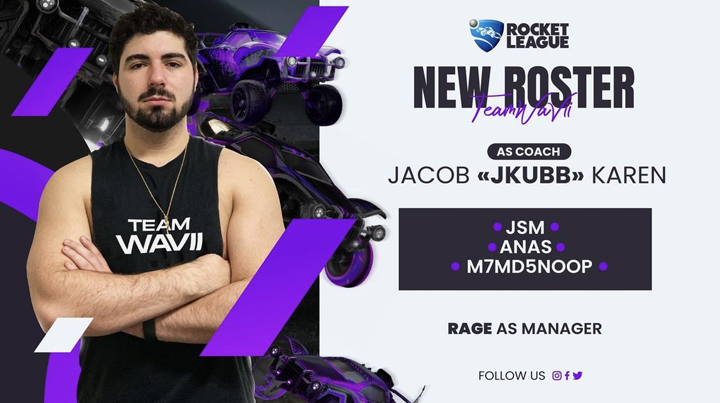The following story originally appeared in the summer 2022 issue of Global Minded, a magazine produced by W&M’s Reves Center for International Studies. Read the full story on the Global Minded website. – Ed.
William & Mary’s esports initiative and its international connections have taken root and are growing.
According to a 2022 Global Esports & Live Streaming Market Report, Newzoo.com and Insider Intelligence, global esports reached an audience of 532,000,000 this year, an 8.7% increase from 2021. The industry generated $1.38 in revenue, and in Latin America alone, one of the fastest-rising regions in esports, that total is expected to reach $42 million by 2023, per PwC estimates.
Meeting with the provost
At Esports Community Day last fall, Provost Peggy Agouris recalled her first encounter with esports at William & Mary.
“One nice day in fall 2019, a group of people walked into my office and gave me the most coordinated and exciting presentation that I had ever heard up to that point at William & Mary,” said Agouris. “Karen [Connor], Terry [Trojak) and Michele [King] walked in and they sat around the table and said, ‘We have an idea.’”
Agouris found their idea compelling: to start something new in an area that W&M wasn’t known for, and yet, “combines the spirit of what it is to be a William & Mary student the excellence, the creativity and the competitive drive to excel.”
The provost’s question to them at the time, was “How can we become pioneers in this?”
Pioneering an esports infrastructure
King feels part of her mission is to make sure W&M is known as not simply a participant player in esports, but a unique one.
And so, King and her colleagues first researched how they wanted to set up the varsity gamers. They decided to join EGF — Electronic Gaming Federation — the Division I governing body for esports. EGFC League states in its mission that it places “an equal emphasis on competition, academics and the physical and mental well-being of our students. EGFC’s game-agnostic approach to collegiate esports ensures that our programs are sustainable for the long term.”
But mere membership in EGF was not enough.
“We are with 47 other Division I schools, and there were seven Board of Governors members, and I said, ‘Well, William & Mary’s got to be a pioneer. We’ve got to do this,’” King said.
King ran for their Board of Governors and was elected.
And as a result of that election, King and William & Mary caught the eye of Zsuzsa James, Team Finland Coordinator for the Video Games & Esports Consulate General of Finland in Los Angeles, who was seeking input on best practices for expanding Finland’s esports industry.
In April 2021, King was invited to be a speaker at a roundtable — “Building a Supportive Esports Ecosystem” — sponsored by Finns & Friends of Esports of the Finland Trade Commission.
“They’re not members of EGF, but they know of EGF because of the prestige it has, and they wanted someone from the education realm,” said King. “They had people from the industry from all over the world, but they had only one person from education, and that was me.”
King’s biggest takeaway from the roundtable?
“We are so far behind. We need to decide, are we going to stand on the sidelines, or are we going to get in the game to prepare our students for this billion-dollar industry?”
As is probably clear by now, ‘standing on the sidelines’ is not in King’s nature.
Preparing students for a new landscape
In March 2019, W&M founded the Esports Training and Research Center (ETARC). It is set up as a collaborative and interdisciplinary program by design.
King understands that among students, there are going to be different levels of involvement in esports, as well as areas of interest. And that’s ok with King.
“Some of [the students] are on the club level, some of them are actually with the varsity level and that’s the beauty of what we’re doing; we’re doing both the academic and applied. The academic is the learning and the classes. The applied is the competitive varsity level. You put those two together, and we have such a beautiful, experiential opportunity for our students.”

The esports industry encompasses multiple roles and opportunities, and ETARC will provide space to develop any and all of the possibilities for students. “Like the NFL, not everyone’s going to be an athlete on the field. But you’ve got producers, casters [similar to play-by-play in sports], event planners, as well as statisticians and data analysts,” King explains. “We can prepare our students. We can get them pipelines into this growing industry and prepare them for this new landscape.”
In addition to career preparation, William & Mary will also focus on wellness and community. “It is a missing piece in the esports industry, so I want W&M to pioneer and be the first premier university to research and to focus on wellness and the flourishing gamer,” King states. “That’s why we’re partnering and working with Dr. Kelly Crace, Director of the W&M CMAX (Center for Mindfulness and Authentic Excellence) and the Wellness Center. We want to make sure that they are flourishing.”
Global Reach: W&M and esports in the world
“Esports are dynamic creations, becoming cultural phenomena which attracts thousands of eager viewers. Their existence has been international since their inception [in South Korea in the 2000s]. Yet they have also been hugely overlooked, and only now are receiving the acknowledgement that they deserve.”
Harvard International Review
In 2019 Tyler Brent ’15 hosted an eSports Envoy during his tour at the U.S. Consulate in Guangzhou. The program is an initiative of the Bureau of Educational and Cultural Affairs (ECA) at the U.S. State Department.
“We worked with ECA’s Office of Sports Diplomacy to bring both an NBA player and an NBA2k player to China for a week of programming,” said Brent.
Michael “BearDaBeast” Key was the eSports Envoy, joined by NBA Player Bonzi Wells. In an interview after his experience, Key was surprised by his reception in China.
“It was actually crazy,” he said. “I was with a former NBA player, so when I see Bonzi Wells walk into an arena and kids are going crazy and screaming, and then I walk into an esports arena and they are going crazy, for me too it’s amazing to see. The reaction Bonzi got was the same reaction I got and that was pretty cool. Esports is huge over there.
“Here we might see singers or actors on posters as advertisements. Over there, they have gamers and controllers on posters and advertisements. It’s so different. I can’t describe how big it is. How we go to an arcade, they have gaming centers and places to game in high schools.”
Key’s assessment of opportunities in 2019 notwithstanding, today in the U.S. today, gamers have increasing options at universities, let alone high school. In the U.S., the esports industry has been gaining momentum in higher education and is picking up speed. Membership in the two major national organizations — the National Association of Collegiate Esports (NACE) and EGF — tops 200 and universities around the world are also enthusiastic.
Crossing national borders
Barrett Ratzlaff ’22 majored in Chinese language and culture and worked as the peer assistant for international events for ISSP. His game is Super Smash Bros. Ultimate, and he received the 2020-2021 Green & Gold Leadership Award from William & Mary’s esports program. The Green & Gold (GG) Leadership Award is bestowed upon the individual who most “inspires others to work creatively and collaboratively by promoting a positive, respectful and supportive environment. The recipient demonstrates initiative to organize events and champion the values, goals and mission of the W&M Academic & Applied Esports program.”
Ratzlaff sees the way esports reaches across cultural boundaries.
“Apart from the NBA and soccer, I can’t think of many sports that a considerable chunk of American and international students both enjoy,” Ratzlaff said. “There are several international students working on the applied side of the esports program, and many more that are fans and players themselves. Different places favor different games, but everyone is experiencing the same growth that comes from competing.”

Why does he think esports is such a global phenomenon?
“The barriers to entry are lower than most competitive outlets, and it’s easier to popularize video games than regular sports,” Ratzlaff explained. “A sport is popular in a certain region because over decades or even centuries that sport became synonymous with a culture. A video game doesn’t have that same kind of process. Something can become popular overnight. The Internet is the main reason why it’s global.”
Ratzlaff started playing video games in 2008 with Pokemon Emerald, so although the esports program didn’t exist when he was applying to college, he sees the value of the esports program, “providing a place where people are able to compete in a healthy way and experience growth.”
“Hundreds of people are part of the esports program and can experience that to some degree,” he said. “As for the international community, it provides yet another way for us to make our campus a global one. For two roommates, it might be a common interest that forms a friendship. For two members of the esports program, it can provide an avenue to push each other to work hard and improve. I think it’s only natural for people to learn more about themselves when they do things like that.”
One of William & Mary’s varsity players is Jacob Karen ’23, a double major in business analytics data science and computer science. He is from Northern Virginia but coaches internationally. Karen plays Rocket League and has developed a name for himself as both a player and a coach of the MENA Saudi Arabian Rocket League Pro Team, WaVii. Their manager contacted Karen on Discord, asking him to try out as their coach. He didn’t think he had a chance, but they hired him, and from there his reputation and skill in playing and coaching has grown.

One thing he has learned is how strategies — or metas — differ in different parts of the world. “Between NA (North America) and MENA (Middle East and North Africa) there’s a huge difference. There is also a difference between NA and the EU. EU players are generally known to play more of a team-based style, more passing. U.S. players are known to play more aggressively, but with a set and tight rotation compared to the Middle East, which has no rotation and they hit the ball as hard as they can. In a region like the Middle East, the meta of the game is completely different than in other regions, because it’s just developing there. So when you have a coach from the United States go over to the to the Middle East and teach them meta that is played in other countries or United States specifically, they learn and adapt to that meta and end up beating teams in their region with the U.S. meta.”
As their coach, his team’s success reflects on him. “As my team grows and develops and becomes one of the better teams in the region, they start to get a global fan base. The coach is not overlooked, because when a team goes from nothing to the top it’s generally not just the team that did that themselves.”
He also learns ways to improve his own game.
“It’s funny because, even as a coach, if I looked at my own replays and didn’t know they were my replays I’d be able to help myself.”

